这里写自定义目录标题
引入
树是一种特殊(无联通)的图
图不一定是树
树关注的节点(顶点)中存的值
图关注的是顶点及边(边可以代表两个顶点之间的关系)
图分为有向(类似单向链表)和和无向(类似双向链表)
图的存储结构
邻接矩阵
表示两个顶点的关系
无向图是一个对称矩阵
附带权值
邻接矩阵优势:
1.邻接矩阵存储方式非常适合稠密图
2.O(1)的判断俩个顶点的连接关系,并取到权值
…
缺点:
1.稀疏图
2.(相对而言)不适合查找一个顶点连接所有边,O(N);
邻接表
类似哈希表
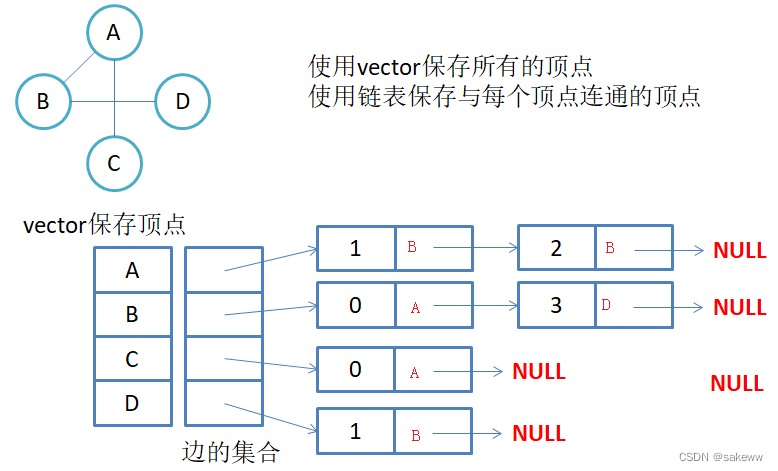
优点:
1.适合存储稀疏图
2.适合查找一个顶点连接出去的边
缺点:
1.不适合确定两个顶点是否相连及权值
一般不需要存储入边表
总结:
邻接矩阵和邻接表属于相辅相成,各有优缺点的互补结构
概念
图是由顶点集合及顶点间的关系组成的一种数据结构:G = (V, E),其中:顶点集合V = {x|x属于某个数据对象集}是有穷非空集合;
E = {(x,y)|x,y属于V}或者E = {<x, y>|x,y属于V && Path(x, y)}是顶点间关系的有穷集合,也叫做边的集合。
(x, y)表示x到y的一条双向通路,即(x, y)是无方向的;Path(x, y)表示从x到y的一条单向通路,即Path(x, y)是有方向的。
顶点和边:图中结点称为顶点,第i个顶点记作vi。两个顶点vi和vj相关联称作顶点vi和顶点vj之间有一条边,图中的第k条边记作ek,ek = (vi,vj)或<vi,vj>。
有向图和无向图:在有向图中,顶点对<x, y>是有序的,顶点对<x,y>称为顶点x到顶点y的一条边(弧),<x, y>和<y, x>是两条不同的边,比如下图G3和G4为有向图。在无向图中,顶点对(x, y)是无序的,顶点对(x,y)称为顶点x和顶点y相关联的一条边,这条边没有特定方向,(x, y)和(y,x)是同一条边,
完全图:在有n个顶点的无向图中,若有n * (n-1)/2条边,即任意两个顶点之间有且仅有一条边,则称此图为无向完全图,比如上图G1;在n个顶点的有向图中,若有n * (n-1)条边,即任意两个顶点之间有且仅有方向相反的边,则称此图为有向完全图
邻接顶点:在无向图中G中,若(u, v)是E(G)中的一条边,则称u和v互为邻接顶点,并称边(u,v)依附于顶点u和v;在有向图 G中,若<u, v>是E(G)中的一条边,则称顶点u邻接到v,顶点v邻接自顶点u,并称边<u, v>与顶点u和顶点v相关联。
顶点的度:顶点v的度是指与它相关联的边的条数,记作deg(v)。在有向图中,顶点的度等于该顶点的入度与出度之和,其中顶点v的入度是以v为终点的有向边的条数,记作indev(v);顶点v的出度是以v为起始点的有向边的条数,记作outdev(v)。因此:dev(v) = indev(v) + outdev(v)。注意:对于无向图,顶点的度等于该顶点的入度和出度,即dev(v) = indev(v) = outdev(v)。
路径:在图G = (V, E)中,若从顶点vi出发有一组边使其可到达顶点vj,则称顶点vi到顶点vj的顶点序列为从顶点vi到顶点vj的路径。一个点到另一个点的路径个数
路径长度:对于不带权的图,一条路径的路径长度是指该路径上的边的条数;对于带权的图,一条路径的路径长度是指该路径上各个边权值的总和。
简单路径与回路:若路径上各顶点v1,v2,v3,…,vm均不重复,则称这样的路径为简单路径。若路径上第一个顶点v1和最后一个顶点vm重合,则称这样的路径为回路或环
子图:设图G = {V, E}和图G1 = {V1,E1},若V1属于V且E1属于E,则称G1是G的子图类似子树,我的顶点是你的部分顶点,我的边是你的部分边
(重要)连通图:在无向图中,若从顶点v1到顶点v2有路径,则称顶点v1与顶点v2是连通的。如果图中任意一对顶点都是连通的,则称此图为连通图。
(重要)强连通图:在有向图中,若在每一对顶点vi和vj之间都存在一条从vi到vj的路径,也存在一条从vj到vi的路径,则称此图是强连通图。
(重要)生成树:在无向图中,一个连通图的最小连通子图称作该图的生成树。有n个顶点的连通图的生成树有n个顶点和n-1条边用最少的边将其连接起来
代码实现
邻接矩阵
//邻接矩阵
namespace matrix
{
//V:顶点 W:权值 Direction:有无向
template<class V, class W, W MAX_W = INT_MAX, bool Direction = false>
class Graph
{
public:
//图的创建
//1.IO输入--不方便测试,oj中更适合
//2.图结构关系写到文件,读取文件
//3.手动添加边
Graph(const V* vertexs, size_t n)
{
_vertexs.reserve(n);
for (size_t i = 0; i < n; ++i)
{
_vertexs.push_back(vertexs[i]);
_indexmap[vertexs[i]] = i;
}
_matrix.resize(n);
for (auto& e : _matrix)
{
e.resize(n, MAX_W);
}
}
//寻找顶点下标
size_t GetVertexIndex(const V& v)
{
auto it = _indexmap.find(v);
if (it != _indexmap.end())
{
return it->second;
}
else {
throw invalid_argument("顶点不存在");
return -1;
}
}
//添加边
//src dst顶点 w权值
void AddEdge(const V& src, const V& dst, const W& w)
{
size_t srci = GetVertexIndex(src);
size_t dsti = GetVertexIndex(dst);
_matrix[srci][dsti] = w;
if (Direction == false)
{
_matrix[dsti][srci] = w;
}
}
void Print()
{
for (int i = 0; i < _vertexs.size(); ++i)
{
cout << "[" << i << "]->" << _vertexs[i] << endl;
}
cout << endl;
//矩阵
cout << " ";
for (size_t i = 0; i < _vertexs.size(); ++i)
{
cout << i << " ";
}
cout << endl;
for (size_t i = 0; i < _matrix.size(); ++i)
{
cout << i << " ";
for (size_t j = 0; j < _matrix[i].size(); ++j)
{
if (_matrix[i][j] != MAX_W)
cout << _matrix[i][j] << " ";
else
cout << "#" << " ";
}
cout << endl;
}
cout << endl;
}
private:
vector<V> _vertexs;//顶点集合
map<V, int> _indexmap;//顶点映射下标
vector<vector<W>> _matrix;//邻接矩阵
};
void TestGraph()
{
Graph<char, int, INT_MAX, true> g("0123", 4);
g.AddEdge('0', '1', 1);
g.AddEdge('0', '3', 4);
g.AddEdge('1', '3', 2);
g.AddEdge('1', '2', 9);
g.AddEdge('2', '3', 8);
g.AddEdge('2', '1', 5);
g.AddEdge('2', '0', 3);
g.AddEdge('3', '2', 6);
g.Print();
}
}
邻接表
//邻接表-出边表
namespace link_table
{
template<class W>
struct Edge
{
int _dsti;//目标点下标
W _w; //权值
Edge<W>* _next;
Edge(int dsti,const W w)
:_dsti(dsti)
,_w(w)
,_next(nullptr)
{}
};
//V:顶点 W:权值 Direction:有无向
template<class V, class W, bool Direction = false>
class Graph
{
typedef Edge<W> Edge;
public:
Graph(const V* a, size_t n)
{
_vertexs.reserve(n);
for (size_t i = 0; i < n; ++i)
{
_vertexs.push_back(a[i]);
_indexmap[a[i]] = i;
}
_tables.resize(n,nullptr);
}
//寻找顶点下标
size_t GetVertexIndex(const V& v)
{
auto it = _indexmap.find(v);
if (it != _indexmap.end())
{
return it->second;
}
else {
throw invalid_argument("顶点不存在");
return -1;
}
}
//添加边
//src dst顶点 w权值
void AddEdge(const V& src, const V& dst, const W& w)
{
size_t srci = GetVertexIndex(src);
size_t dsti = GetVertexIndex(dst);
//a->b
Edge *eg = new Edge(dsti,w);
eg->_next = _tables[srci];
_tables[srci] = eg;
//b->a
if (Direction == false)
{
Edge* eg = new Edge(srci, w);
eg->_next = _tables[dsti];
_tables[dsti] = eg;
}
}
void Print()
{
for (int i = 0; i < _vertexs.size(); ++i)
{
cout << "[" << i << "]->" << _vertexs[i] << endl;
}
cout << endl;
for (int i = 0; i < _tables.size(); ++i)
{
cout << _vertexs[i] << "[" << i << "]->";
Edge* cur = _tables[i];
while (cur)
{
cout << _vertexs[cur->_dsti] << ":[" << cur->_dsti << "]:"<<cur->_w<<"->";
cur = cur->_next;
}
cout << "nullptr" << endl;
}
}
private:
vector<V> _vertexs; //顶点集合
map<V, int> _indexmap;//顶点映射下标
vector<Edge*> _tables;//邻接表
};
void TestGraph()
{
string a[] = { "张三", "李四", "王五", "赵六" };
Graph<string, int> g1(a, 4);
g1.AddEdge("张三", "李四", 100);
g1.AddEdge("张三", "王五", 200);
g1.AddEdge("王五", "赵六", 30);
g1.Print();
}
}
图的遍历
针对的是图的顶点
广度优先遍历bfs

进行测试

void BFS(const V& src)
{
int srci = GetVertexIndex(src);
//队列和标记数组
queue<int> q;
vector<bool> visited(_vertexs.size(), false);
q.push(srci);
visited[srci] = true;
while (!q.empty())
{
int front = q.front();
q.pop();
cout << front << ":" << _vertexs[front] << endl;;
for (size_t i = 0; i < _vertexs.size(); ++i)
{
if (visited[i] == false && _matrix[front][i] != MAX_W)
{
visited[i] = true;
q.push(i);
}
}
}
}
void Test()
{
string a[] = { "张三", "李四", "王五", "赵六", "周七" };
Graph<string, int> g1(a, sizeof(a) / sizeof(string));
g1.AddEdge("张三", "李四", 100);
g1.AddEdge("张三", "王五", 200);
g1.AddEdge("王五", "赵六", 30);
g1.AddEdge("王五", "周七", 30);
g1.Print();
g1.BFS("张三");
//g1.DFS("张三");
}

深度优先遍历dfs
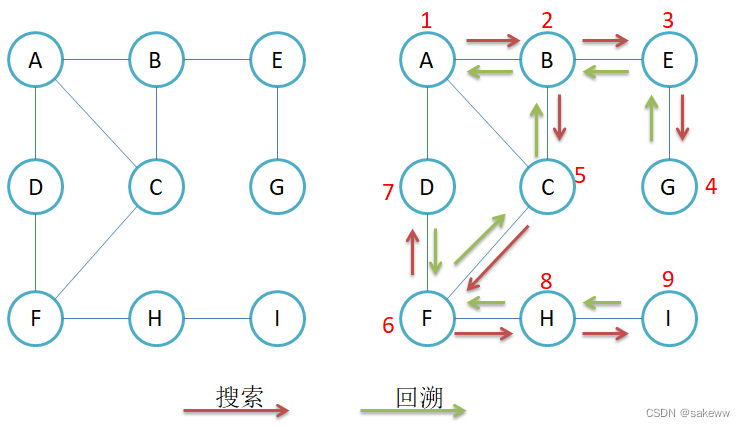
进行测试

void _DFS(int srci, vector<bool> visited)
{
cout << srci << ":" << _vertexs[srci] << endl;
visited[srci] = true;
for (size_t i = 0; i < visited.size(); i++)
{
if (_matrix[srci][i] != MAX_W && visited[i] == false)
_DFS(i, visited);
}
}
void DFS(const V& src)
{
vector<bool> visited(_vertexs.size(), false);
_DFS(GetVertexIndex(src), visited);
}
void TestGraphDBFS()
{
//为了使得测试更加明显,将李四和王五的位置进行了调整
string a[] = { "张三", "王五", "李四", "赵六", "周七" };
Graph<string, int> g1(a, sizeof(a) / sizeof(string));
g1.AddEdge("张三", "王五", 200);
g1.AddEdge("张三", "李四", 100);
g1.AddEdge("王五", "赵六", 30);
g1.AddEdge("王五", "周七", 30);
g1.Print();
cout << "BFS" << endl;
g1.BFS("张三");
cout << "DFS" << endl;
g1.DFS("张三");
}

矩阵不适合走深度和广度
原因:两个点是否相连不是很容易确定
最小生成树
引入
深度和广度遍历节点的时候
如果给的图不是连通图,那么以某个点为起点,就不能将其遍历完成,
概念回顾
(重要)连通图:在无向图中,若从顶点v1到顶点v2有路径,则称顶点v1与顶点v2是连通的。如果图中任意一对顶点都是连通的,则称此图为连通图。
(重要)生成树:在无向图中,一个连通图的最小连通子图称作该图的生成树。有n个顶点的连通图的生成树有n个顶点和n-1条边用最少的边将其连接起来
概念
构成生成树的这些边加起来权值是最小的
连通图中的每一棵生成树,都是原图的一个极大无环子图,即:从其中删去任何一条边,生成树就不在连通;反之,在其中引入任何一条新边,都会形成一条回路。
若连通图由n个顶点组成,则其生成树必含n个顶点和n-1条边。因此构造最小生成树的准则有三条:
1. 只能使用图中权值最小的边来构造最小生成树
2. 只能使用恰好n-1条边来连接图中的n个顶点
3. 选用的n-1条边不能构成回路
构造最小生成树的方法:Kruskal算法和Prim算法。这两个算法都采用了逐步求解的贪心策略。
贪心算法:是指在问题求解时,总是做出当前看起来最好的选择。也就是说贪心算法做出的不是整体
最优的的选择,而是某种意义上的局部最优解。贪心算法不是对所有的问题都能得到整体最优解
Kruskal算法–克鲁斯卡尔算法
这样也是最终结果,即:最小生成树不唯一
判环-并查集
W Kruskal(Self& minTree)
{
int n = _vertexs.size();
minTree._vertexs = _vertexs;
minTree._indexmap = _indexmap;
minTree._matrix.resize(n);
for (int i = 0; i < n; i++)
{
minTree._matrix[i].resize(n, MAX_W);
}
priority_queue<Edge,vector<Edge>,greater<Edge>> minq;
for (int i = 0; i < n; i++)
{
for (int j = 0; j < n; j++)
{
if (i < j && _matrix[i][j] != MAX_W)
{
minq.push(Edge(i, j, _matrix[i][j]));
}
}
}
int size = 0;
W totalW = W();
//选出n-1条边
UnionFindSet ufs(n);
while (!minq.empty())
{
Edge Min = minq.top();
minq.pop();
if (!ufs.InSet(Min._srci, Min._dsti))
{
//cout << _vertexs[Min._srci] << "-" << _vertexs[Min._dsti] <<
":" << _matrix[Min._srci][Min._dsti] << endl;
minTree._AddEdge(Min._srci, Min._dsti,Min._w);
ufs.Union(Min._srci, Min._dsti);
++size;
totalW += Min._w;
}
else {
//cout << "构成环:";
//cout << _vertexs[Min._srci] << "-" << _vertexs[Min._dsti] <<
":" << _matrix[Min._srci][Min._dsti] << endl;
}
}
if (size == n - 1)
{
return totalW;
}
else {
return W();
}
}
Prim算法–普利姆算法
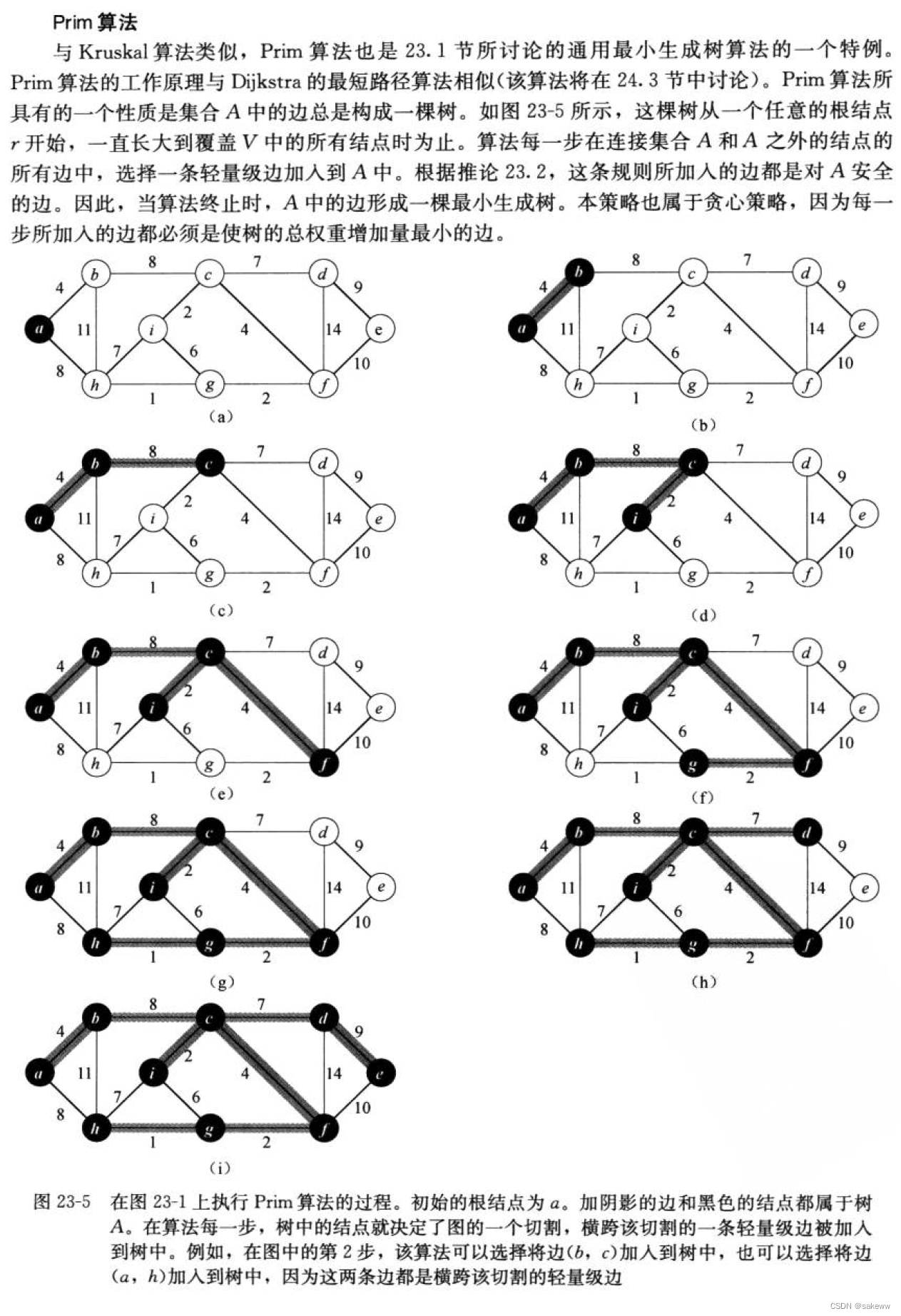
优势:
选边的时候,不会构成环
W Prim(Self& minTree,const W& src)
{
size_t srci = GetVertexIndex(src);
size_t n = _vertexs.size();
minTree._vertexs = _vertexs;
minTree._indexmap = _indexmap;
minTree._matrix.resize(n);
for (size_t i = 0; i < n; i++)
{
minTree._matrix[i].resize(n, MAX_W);
}
vector<bool> X(n,false);
vector<bool> Y(n,true);
X[srci] = true;
Y[srci] = false;
//X->Y集合中连接的边中选出最小的边
priority_queue<Edge, vector<Edge>, greater<Edge>> minq;
//将srci连接的边添加到队列中
for (size_t i = 0; i < n; i++)
{
if (_matrix[srci][i] != MAX_W)
{
minq.push(Edge(srci, i, _matrix[srci][i]));
}
}
size_t i = 0;
W totalW = W();
while (!minq.empty())
{
Edge min = minq.top();
minq.pop();
if(X[min._dsti])
{
cout << "构成环:";
cout << _vertexs[min._srci] << "-" << _vertexs[min._dsti] << \
":" << _matrix[min._srci][min._dsti] << endl;
}
else
{
minTree._AddEdge(min._srci, min._dsti, min._w);
X[min._dsti] = true;
Y[min._dsti] = false;
++i;
totalW += min._w;
if (i == n)
break;
cout << _vertexs[min._srci] << "-" << _vertexs[min._dsti] << \
":" << _matrix[min._srci][min._dsti] << endl;
for (size_t i = 0; i < n; ++i)
{
if (_matrix[min._dsti][i] != MAX_W && X[i]==false)//X.count(i)统计X中i的个数
{
minq.push(Edge(min._dsti, i, _matrix[min._dsti][i]));
}
}
}
}
if (i == n - 1)
{
return totalW;
}
else {
return W();
}
}
最短路径
最短路径问题:从在带权有向图 G中的某一顶点出发,找出一条通往另一顶点的最短路径,最短也就是沿路径各边的权值总和达到最小
单源最短路径–Dijkstra算法–迪克斯特拉算法
单源最短路径问题:给定一个图G = ( V , E ) G=(V,E)G=(V,E),求源结点s ∈ V s∈Vs∈V到图中每个结点v ∈ V v∈Vv∈V的最短路径。Dijkstra算法就适用于解决带权重的有向图上的单源最短路径问题 ,同时算法要求图中所有边的权重非负。一般在求解最短路径的时候都是已知一个起点和一个终点,所以使用Dijkstra算法求解过后也就得到了所需起点到终点的最短路径。
Dijkstra算法存在的问题是不支持图中带负权路径,如果带有负权路径,则可能会找不到一些路径的最短路径。
个人思路:
时间复杂度:O(N^2)
空间复杂度:O(N)
代码
void PrintShortPath(const V& src, const vector<W>& dist, const vector<int>& pPath)
{
size_t srci = GetVertexIndex(src);
size_t n = _vertexs.size();
for (size_t i = 0; i < n; ++i)
{
if (i != srci)
{
// 找出i顶点的路径
vector<int> path;
size_t parenti = i;
while (parenti != srci)
{
path.push_back(parenti);
parenti = pPath[parenti];
}
path.push_back(srci);
reverse(path.begin(), path.end());
for (auto index : path)
{
cout << _vertexs[index] << "->";
}
cout << dist[i] << endl;
}
}
}
void Dijkstra(const V& src, vector<W>& dist, vector<int>& pPath)
{
size_t srci = GetVertexIndex(src);
size_t n = _vertexs.size();
dist.resize(n, MAX_W);
pPath.resize(n, -1);
dist[srci] = 0;
pPath[srci] = srci;
// 已经确定最短路径的顶点集合
vector<bool> S(n, false);
for (size_t j = 0; j < n; ++j)
{
// 选最短路径顶点且不在S更新其他路径
int u = 0;
W min = MAX_W;
for (size_t i = 0; i < n; ++i)
{
if (S[i] == false && dist[i] < min)
{
u = i;
min = dist[i];
}
}
S[u] = true;
// 松弛更新u连接顶点v srci->u + u->v < srci->v 更新
for (size_t v = 0; v < n; ++v)
{
if (S[v] == false && _matrix[u][v] != MAX_W
&& dist[u] + _matrix[u][v] < dist[v])
{
dist[v] = dist[u] + _matrix[u][v];
pPath[v] = u;
}
}
}
}
void TestGraphDijkstra()
{
//const char* str = "syztx";
//Graph<char, int, INT_MAX, true> g(str, strlen(str));
//g.AddEdge('s', 't', 10);
//g.AddEdge('s', 'y', 5);
//g.AddEdge('y', 't', 3);
//g.AddEdge('y', 'x', 9);
//g.AddEdge('y', 'z', 2);
//g.AddEdge('z', 's', 7);
//g.AddEdge('z', 'x', 6);
//g.AddEdge('t', 'y', 2);
//g.AddEdge('t', 'x', 1);
//g.AddEdge('x', 'z', 4);
//vector<int> dist;
//vector<int> parentPath;
//g.Dijkstra('s', dist, parentPath);
//g.PrintShortPath('s', dist, parentPath);
const char* str = "sytx";
Graph<char, int, INT_MAX, true> g(str, strlen(str));
g.AddEdge('s', 't', 10);
g.AddEdge('s', 'y', 5);
g.AddEdge('t', 'y', -7);
g.AddEdge('y', 'x', 3);
vector<int> dist;
vector<int> parentPath;
g.Dijkstra('s', dist, parentPath);
g.PrintShortPath('s', dist, parentPath);
//s->y->5
//s->t->10
//s->y->x->8
}
单源最短路径–Bellman-Ford算法–贝尔曼福特算法
Dijkstra算法只能用来解决正权图的单源最短路径问题,但有些题目会出现负权图。这时这个算法就不能帮助我们解决问题了,而bellman—ford算法可以解决负权图的单源最短路径问题。它的优点是可以解决有负权边的单源最短路径问题,而且可以用来判断是否有负权回路。它也有明显的缺点,它的时间复杂度 O(N*E) (N是点数,E是边数)普遍是要高于Dijkstra算法O(N²)的。像这里如果我们使用邻接矩阵实现,那么遍历所有边的数量的时间复杂度就是O(N^3),这里也可以看出来Bellman-Ford就是一种暴力求解更新

时间复杂度:O(N^3)
空间复杂度:O(N)
缺陷:带负权回路的不能计算
代码
bool BellmanFord(const V& src, vector<W>& dist, vector<int>& pPath)
{
size_t n = _vertexs.size();
size_t srci = GetVertexIndex(src);
// vector<W> dist,记录srci-其他顶点最短路径权值数组
dist.resize(n, MAX_W);
// vector<int> pPath 记录srci-其他顶点最短路径父顶点数组
pPath.resize(n, -1);
// 先更新srci->srci为缺省值
dist[srci] = W();
//cout << "更新边:i->j" << endl;
// 总体最多更新n轮
for (size_t k = 0; k < n; ++k)
{
// i->j 更新松弛
bool update = false;
cout << "更新第:" << k << "轮" << endl;
for (size_t i = 0; i < n; ++i)
{
for (size_t j = 0; j < n; ++j)
{
// srci -> i + i ->j
if (_matrix[i][j] != MAX_W && dist[i] + _matrix[i][j] < dist[j])
{
update = true;
cout << _vertexs[i] << "->" << _vertexs[j] << ":" << _matrix[i][j] << endl;
dist[j] = dist[i] + _matrix[i][j];
pPath[j] = i;
}
}
}
// 如果这个轮次中没有更新出更短路径,那么后续轮次就不需要再走了
if (update == false)
{
break;
}
}
// 还能更新就是带负权回路
for (size_t i = 0; i < n; ++i)
{
for (size_t j = 0; j < n; ++j)
{
// srci -> i + i ->j
if (_matrix[i][j] != MAX_W && dist[i] + _matrix[i][j] < dist[j])
{
return false;
}
}
}
return true;
}
void TestGraphBellmanFord()
{
const char* str = "syztx";
Graph<char, int, INT_MAX, true> g(str, strlen(str));
g.AddEdge('s', 't', 6);
g.AddEdge('s', 'y', 7);
g.AddEdge('y', 'z', 9);
g.AddEdge('y', 'x', -3);
g.AddEdge('z', 's', 2);
g.AddEdge('z', 'x', 7);
g.AddEdge('t', 'x', 5);
g.AddEdge('t', 'y', 8);
g.AddEdge('t', 'z', -4);
g.AddEdge('x', 't', -2);
vector<int> dist;
vector<int> parentPath;
if (g.BellmanFord('s', dist, parentPath))
{
cout << endl;
g.PrintShortPath('s', dist, parentPath);
}
else
{
cout << "存在负权回路" << endl;
}
}
// 微调图结构,带有负权回路的测试
const char* str = "syztx";
Graph<char, int, INT_MAX, true> g(str, strlen(str));
g.AddEdge('s', 't', 6);
g.AddEdge('s', 'y', 7);
g.AddEdge('y', 'x', -3);
g.AddEdge('y', 'z', 9);
g.AddEdge('y', 'x', -3);
g.AddEdge('y', 's', 1); // 新增
g.AddEdge('z', 's', 2);
g.AddEdge('z', 'x', 7);
g.AddEdge('t', 'x', 5);
g.AddEdge('t', 'y', -8); // 更改
g.AddEdge('t', 'z', -4);
g.AddEdge('x', 't', -2);
vector<int> dist;
vector<int> parentPath;
if (g.BellmanFord('s', dist, parentPath))
{
g.PrintShortPath('s', dist, parentPath);
}
else
{
cout << "存在负权回路" << endl;
}
多源最短路径–Floyd-Warshall算法-弗洛伊德算法
图中任意两点之间的最短路径问题
代码
void FloydWarshall(vector<vector<W>>& vvDist, vector<vector<int>>& vvpPath)
{
size_t n = _vertexs.size();
vvDist.resize(n);
vvpPath.resize(n);
// 初始化权值和路径矩阵
for (size_t i = 0; i < n; ++i)
{
vvDist[i].resize(n, MAX_W);
vvpPath[i].resize(n, -1);
}
// 直接相连的边更新一下
for (size_t i = 0; i < n; ++i)
{
for (size_t j = 0; j < n; ++j)
{
if (_matrix[i][j] != MAX_W)
{
vvDist[i][j] = _matrix[i][j];
vvpPath[i][j] = i;
}
if (i == j)
{
vvDist[i][j] = W();
}
}
}
// 最短路径的更新i-> {其他顶点} ->j
for (size_t k = 0; k < n; ++k)
{
for (size_t i = 0; i < n; ++i)
{
for (size_t j = 0; j < n; ++j)
{
// k 作为的中间点尝试去更新i->j的路径
if (vvDist[i][k] != MAX_W && vvDist[k][j] != MAX_W
&& vvDist[i][k] + vvDist[k][j] < vvDist[i][j])
{
vvDist[i][j] = vvDist[i][k] + vvDist[k][j];
vvpPath[i][j] = vvpPath[k][j];
}
}
}
// 打印权值和路径矩阵观察数据
for (size_t i = 0; i < n; ++i)
{
for (size_t j = 0; j < n; ++j)
{
if (vvDist[i][j] == MAX_W)
printf("%3c", '*');
else
printf("%3d", vvDist[i][j]);
}
cout << endl;
}
cout << endl;
for (size_t i = 0; i < n; ++i)
{
for (size_t j = 0; j < n; ++j)
printf("%3d", vvpPath[i][j]);
cout << endl;
}
cout << "=================================" << endl;
}
}
void TestFloydWarShall()
{
const char* str = "12345";
Graph<char, int, INT_MAX, true> g(str, strlen(str));
g.AddEdge('1', '2', 3);
g.AddEdge('1', '3', 8);
g.AddEdge('1', '5', -4);
g.AddEdge('2', '4', 1);
g.AddEdge('2', '5', 7);
g.AddEdge('3', '2', 4);
g.AddEdge('4', '1', 2);
g.AddEdge('4', '3', -5);
g.AddEdge('5', '4', 6);
vector<vector<int>> vvDist;
vector<vector<int>> vvParentPath;
g.FloydWarshall(vvDist, vvParentPath);
// 打印任意两点之间的最短路径
for (size_t i = 0; i < strlen(str); ++i)
{
g.PrintShortPath(str[i], vvDist[i], vvParentPath[i]);
cout << endl;
}
}








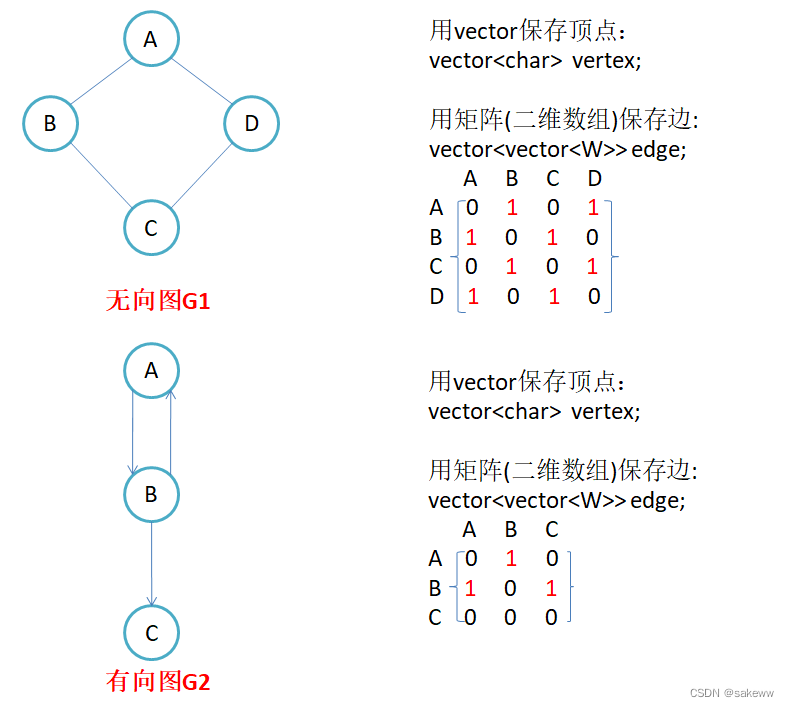
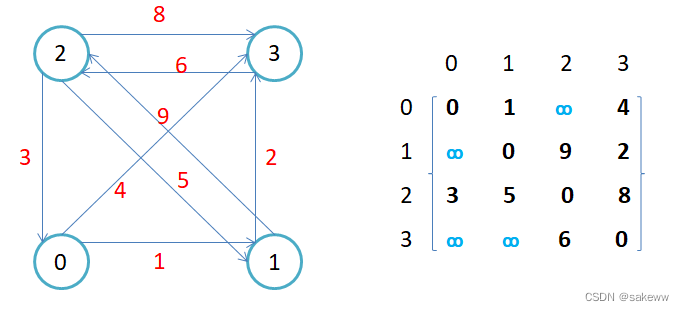
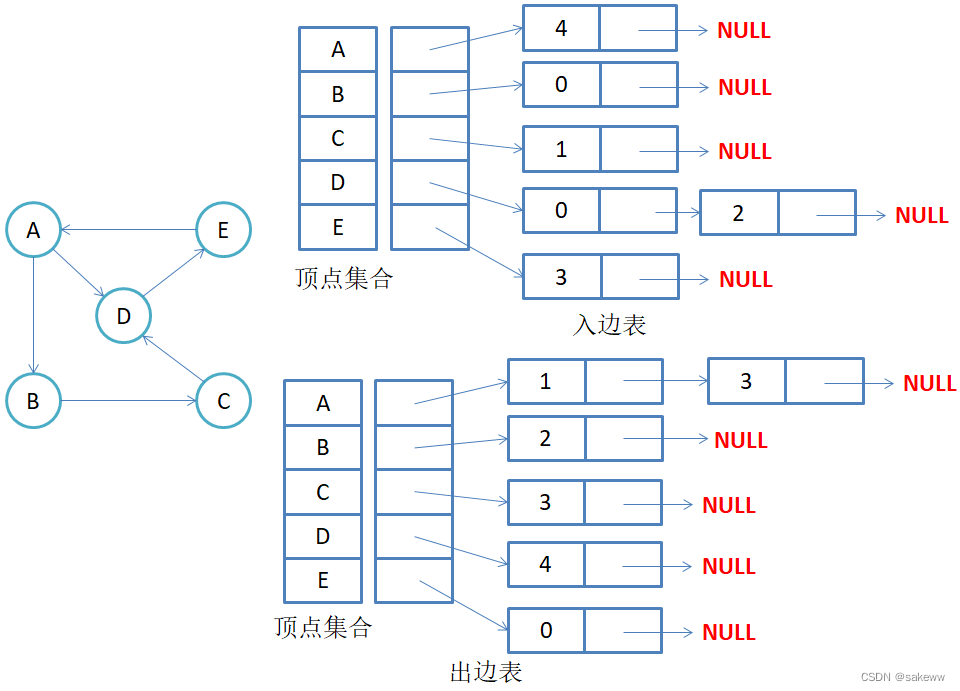
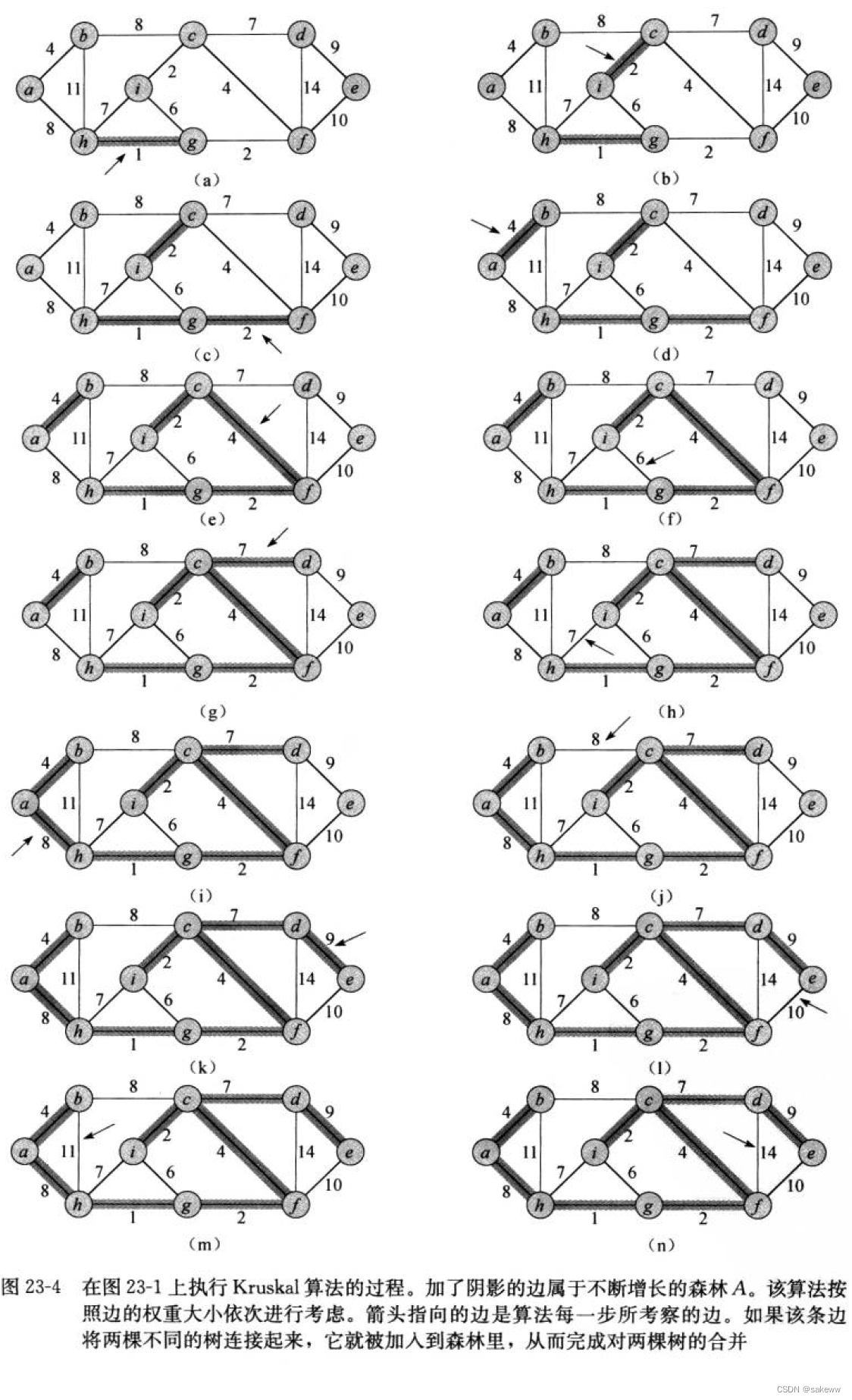

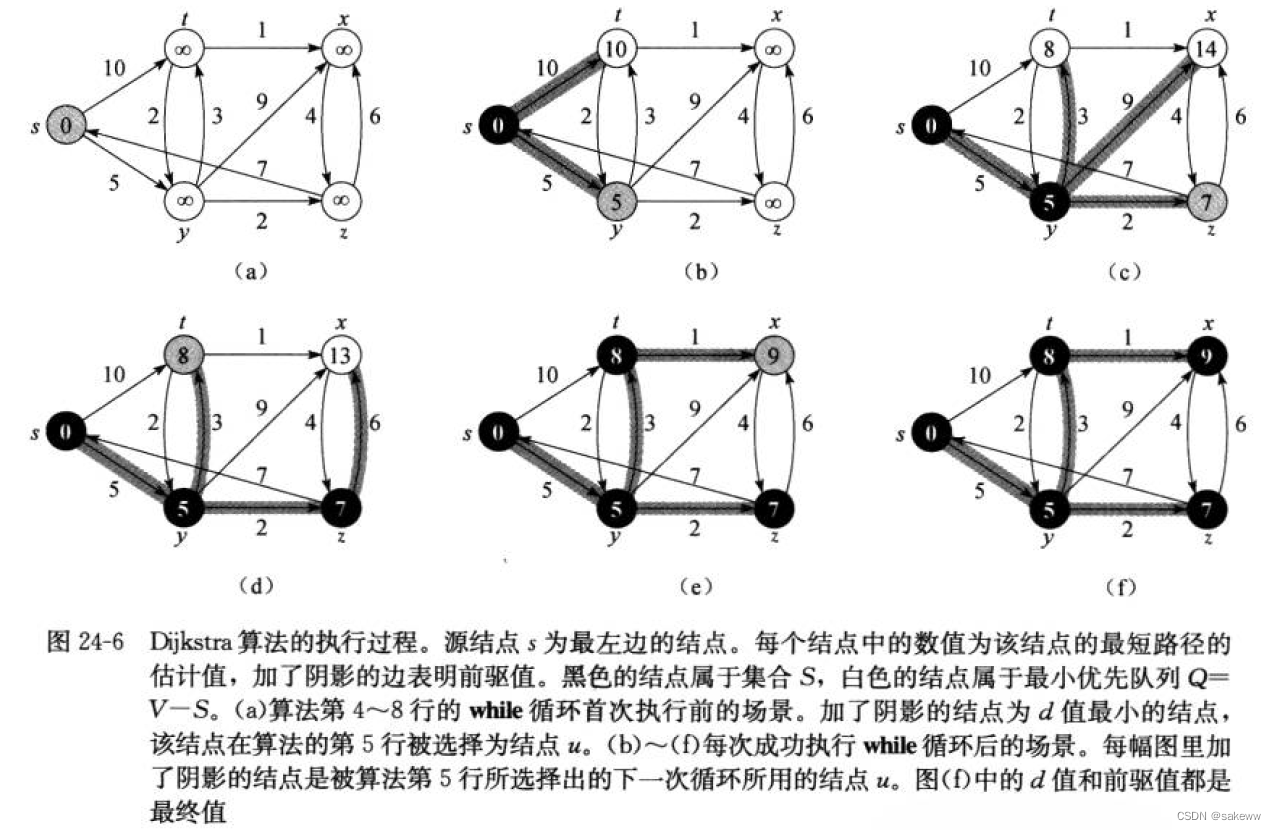

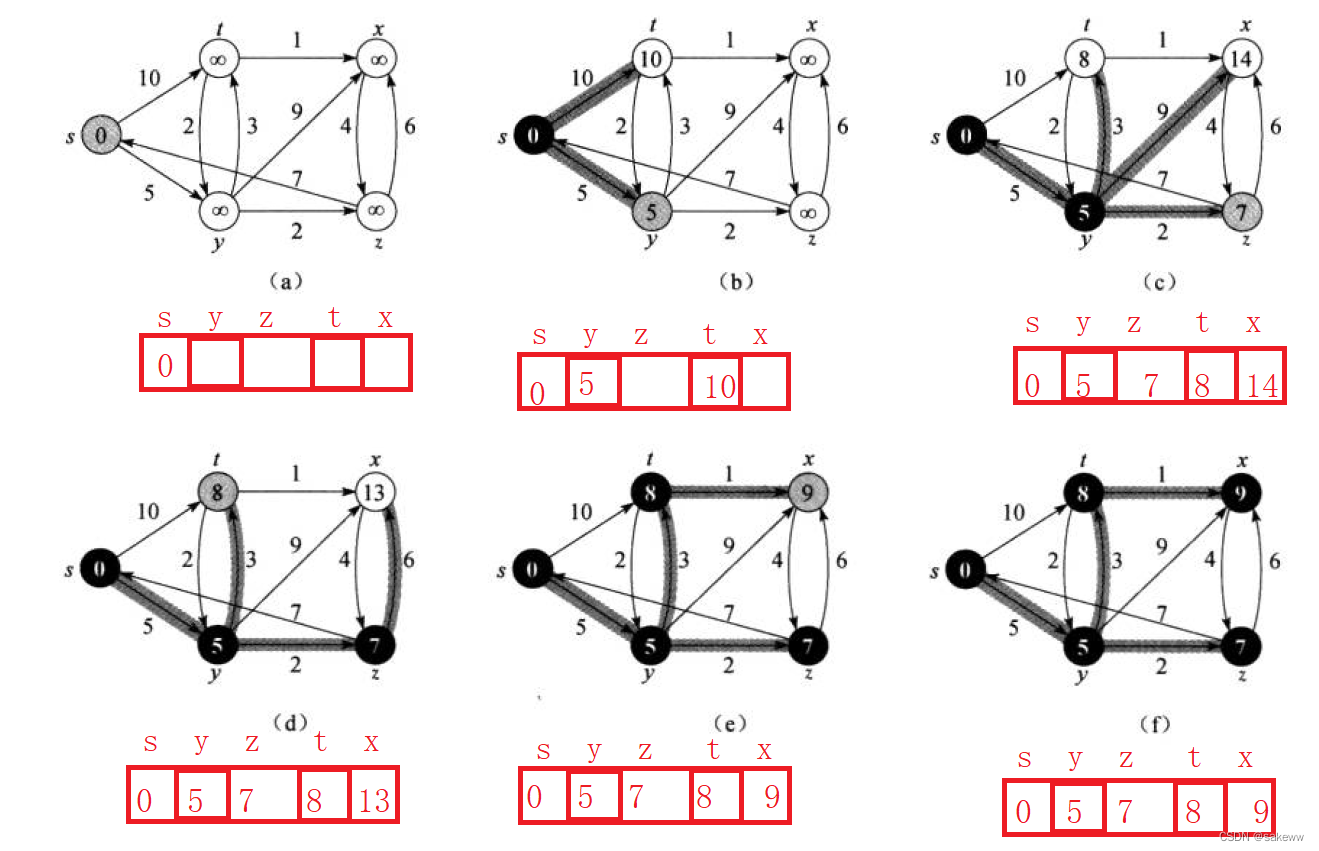
















 被折叠的 条评论
为什么被折叠?
被折叠的 条评论
为什么被折叠?








